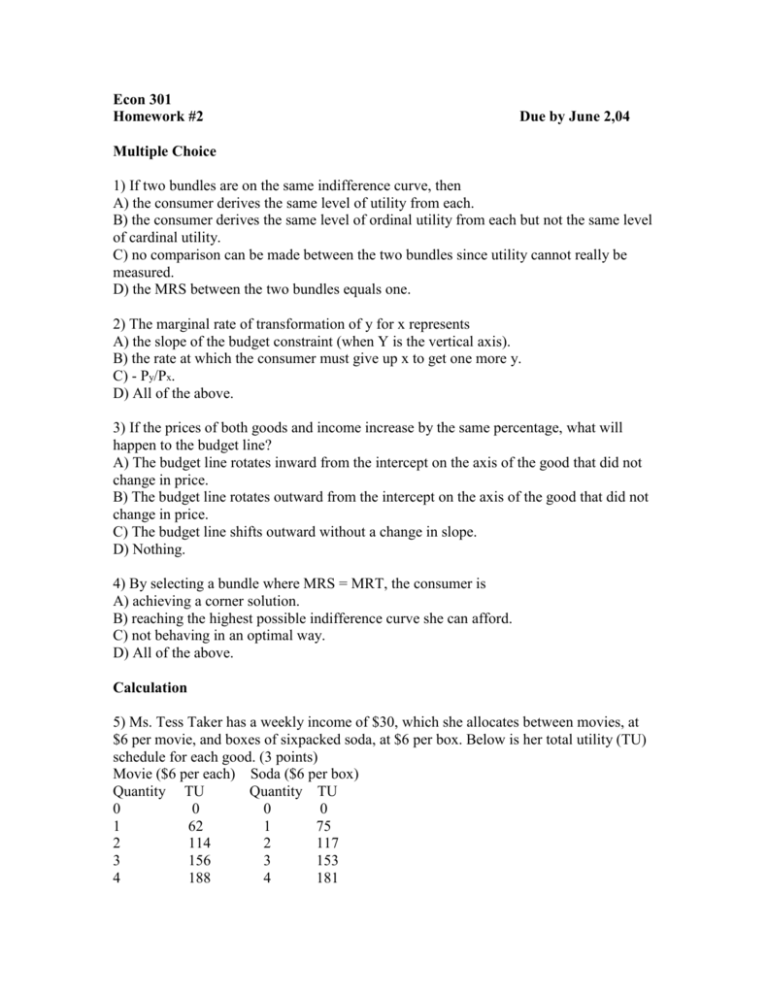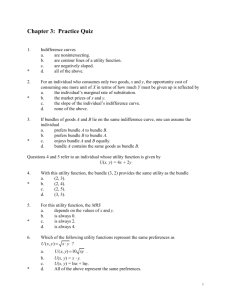Homework 2
advertisement

Econ 301 Homework #2 Due by June 2,04 Multiple Choice 1) If two bundles are on the same indifference curve, then A) the consumer derives the same level of utility from each. B) the consumer derives the same level of ordinal utility from each but not the same level of cardinal utility. C) no comparison can be made between the two bundles since utility cannot really be measured. D) the MRS between the two bundles equals one. 2) The marginal rate of transformation of y for x represents A) the slope of the budget constraint (when Y is the vertical axis). B) the rate at which the consumer must give up x to get one more y. C) - Py/Px. D) All of the above. 3) If the prices of both goods and income increase by the same percentage, what will happen to the budget line? A) The budget line rotates inward from the intercept on the axis of the good that did not change in price. B) The budget line rotates outward from the intercept on the axis of the good that did not change in price. C) The budget line shifts outward without a change in slope. D) Nothing. 4) By selecting a bundle where MRS = MRT, the consumer is A) achieving a corner solution. B) reaching the highest possible indifference curve she can afford. C) not behaving in an optimal way. D) All of the above. Calculation 5) Ms. Tess Taker has a weekly income of $30, which she allocates between movies, at $6 per movie, and boxes of sixpacked soda, at $6 per box. Below is her total utility (TU) schedule for each good. (3 points) Movie ($6 per each) Soda ($6 per box) Quantity TU Quantity TU 0 0 0 0 1 62 1 75 2 114 2 117 3 156 3 153 4 188 4 181 5 210 5 206 i. Suppose Ms. Taker chooses 4 movies and 1 box of soda. Does this satisfy her weekly budget constraint? Calculate the marginal utility of the last dollar spend on each good. ii. Explain why this is not the combination that maximizes Ms. Taker’s total utility subject to her budget constraint. 6) LaTonya’s utility function is U 5 A6 B 2 . The price of A is pa 10 , the price of B is pb 5 , and her income Y, is $200. What is her optimal consumption bundle? How much utility does she receive from this bundle? If her utility function was U = 10A6 B 2 , how would her consumption decision change? 7) What happens to the budget line if the government applies a specific tax of $1 per gallon on gasoline but does not tax other goods? What happens to the budget line of the tax applies only to purchases of gasoline in excess of 10 gallon per week? 8) Review: As a consumer, should you care whether a 15c-per-gallon milk tax is collected from stores or from consumers? Use graphs to explain why or why not. 9) Linda loves buying shoes and going out to dance. Her utility function for pairs of shoes, S, and the number of times she goes dancing per month, T, is U(S,T)=2ST. It costs Linda $50 to buy a new pair of shoes or to spend an evening out dancing. Assume that she has $500 to spend on clothing and dancing. a. What is the equation for her budget line? Draw it (with T on the vertical axis), and label the slope and intercepts. b. What is Linda’s marginal rate of substitution? Explain. c. Solve mathematically for her optimal bundle. Show how to determine this bundle in a diagram using indifference curves and a budget line.











